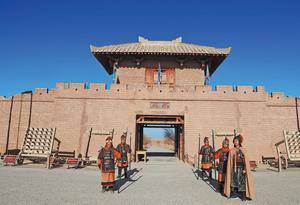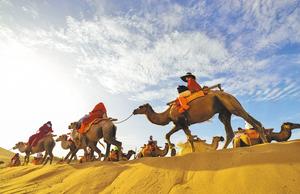In the Dunhuang grottoes and surrounding areas in Gansu province, visitors can hear voices from the dust and sample the flavors of life long ago
 Tourists visit the Mogao Grottoes, a UNESCO World Heritage site with numerous ancient murals and Buddhist statues, in Dunhuang, Gansu province. (PHOTO PROVIDED TO CHINA DAILY)
Tourists visit the Mogao Grottoes, a UNESCO World Heritage site with numerous ancient murals and Buddhist statues, in Dunhuang, Gansu province. (PHOTO PROVIDED TO CHINA DAILY)
Bumping one's way slowly on the back of a camel across the desert of Dunhuang, Gansu province, a modern-day visitor can easily imagine the past, when traders trudged along the ancient Silk Road, chatting and laughing in good spirits as they expected a good harvest.
Dunhuang, which means "grand glory" in English, is a major gateway linking China with the West. Traces of exchanges between different civilizations can be found in the mottled murals and Buddhist statues of its iconic Mogao Grottoes, the rolling sandstone of Echoing-Sand Mountain, a quiet oasis in the Gobi Desert, mysterious ancient graves and numerous earth-tone ruins. All of this attracts more than 10 million tourist visits from around the world every year.
Some tourists are curious about remote, exotic desert scenery, and some have a strong interest in Buddhist art
Zhang Yuping, a taxi driver in Dunhuang, Gansu province
Zhang Yuping, a taxi driver in Dunhuang, said during peak season in July and August, the small city would be packed with tourists. Room prices at four-star hotels and above would be as high as 1,000 yuan (US$154) per night. And he, like the other 1,000 or so local taxi drivers, would work around the clock to serve passengers.
"Some tourists are curious about remote, exotic desert scenery, and some have a strong interest in Buddhist art," he said.
Zhang recalls one of his most memorable clients-an intellectual from Beijing who chartered his car for two days and visited every grotto except the farthest one, Yulin Grottoes, 160 kilometers from downtown, because of a tight travel schedule.
"Ten minutes after I dropped him off at the airport, he called back to say he had canceled the flight and was determined to go to the Yulin Grottoes," Zhang said. "He told me he might not be able to sleep if he just left."
He said the client also paid extra money to see all the specially-protected caves at Mogao Grottoes. Each visit costs 150 to 200 yuan.
 Workers at Yangguan Pass scenic spot, wearing traditional Chinese costumes, welcome tourists in January. (PHOTO PROVIDED TO CHINA DAILY)
Workers at Yangguan Pass scenic spot, wearing traditional Chinese costumes, welcome tourists in January. (PHOTO PROVIDED TO CHINA DAILY)
The number of tourist visits to the city grew by 20 percent annually during the 2017-19 period, according to He Yanhong, deputy director of the Dunhuang culture, sports, radio, television and tourism bureau. Total tourist visits reached around 7.75 million in 2020, about 60 percent of what it was annually before the coronavirus pandemic. However, October and November last year saw a year-on-year increase, after cross-provincial travel recovered in mid-July, he said.
Dunhuang, one of the first cities in China to open to the West, has long been a port of entry along the ancient Silk Road. It borders the Xinjiang Uygur autonomous region on the west, beyond which lies Central Asia-Kazakhstan,Uzbekistan and other countries. Farther still lies Europe.
The path to civilization may be strewn with thorns, but the result of the journey has been remarkable. When envoy Zhang Qian was sent by emperor Wu during the Han Dynasty (206 BC-AD 220) to seek diplomatic alliances with countries and tribes in the West, he passed through Dunhuang and thought it was an important base. So he suggested the emperor to build a city in the barren desert. As officials, soldiers and merchants moved to Dunhuang from inland areas, military fortresses were built at Yangguan Pass and Yumen Pass, and Dunhuang established its name firmly in history.
Its construction also laid the foundation for cultural exchanges.
"A foreign culture will not remain in a cultural desert. As with the human longing for an oasis, culture needs an oasis too," said Wang Xudong, director of Beijing's Palace Museum, in the book The Grottoes Corridor of China. "Dunhuang bridges ancient Chinese, Indian, Greek, Roman and Egyptian civilizations."
For thousands of years, traders speaking different languages came to Dunhuang to buy and sell Chinese silk, tea, porcelain, Western gemstones, spices, horses and fruit. The prosperous social and commercial activity has been depicted in paintings on walls of the ancient grottoes.
 Beacon tower structural remains in Dunhuang. (ZHANG XIAOLIANG / FOR CHINA DAILY)
Beacon tower structural remains in Dunhuang. (ZHANG XIAOLIANG / FOR CHINA DAILY)
Ji Gang, a global partner at consultancy Roland Berger, said as a trade city with multiple languages and a blend of cultures and ethnic characteristics, Dunhuang shows the diversity and inclusiveness of the country. Its architecture, colored sculptures, wall paintings and other artworks were created by ancestors from different regions and eras, and are a priceless treasure for China and the world.
The Mogao Grottoes are a UNESCO World Heritage site with their numerous ancient murals and Buddhist statues in 735 caves. They are a rich resource for artistic and historical exploration.
Back in 366, a monk named Le Zun visited Dunhuang and witnessed a sunset on Sanwei Mountain. He believed the golden light was a sign of Buddha, and regarded it as sacred land. Then he raised money and hired workers to dig the first cave on the mountain so he could sit in meditation.
During the following 10 dynasties, more Buddhist believers, including monks, officials, merchants and members of royalty commissioned Buddhist statues and paintings, and the scale of the grottoes expanded.
However, as the Maritime Silk Road took over as the major channel for exchanges between China and the West, the role of land traffic to Dunhuang faded. After the Yuan Dynasty (1271-1368), construction of grottoes ceased. In 1528, residents moved inland, and Dunhuang became the home of nomads. The grottoes were forgotten for hundreds of years, and many parts were destroyed by wind, water and thieves.
"That's why the remaining caves are so valuable," said Li Ping, head of cultural promotion department at Dunhuang Academy.
 Tourists ride camels at the Echoing-Sand Mountain in Dunhuang. (WANG BINYIN / FOR CHINA DAILY)
Tourists ride camels at the Echoing-Sand Mountain in Dunhuang. (WANG BINYIN / FOR CHINA DAILY)
Since opening to the public in 1979, the number of tourist visits surged from 26,000 to a peak of 2.2 million in 2019. Last year, with visitation reduced by the coronavirus, it welcomed 1.39 million visits. Now, it has about 20,000 foreign visits annually, mainly from Japan, the United States and South Korea.
The attraction offers guided services in six languages-Chinese,English, Japanese, French, Korean and German. All films, exhibitions and signboards have English translations.
In addition to sightseeing, tourists can view the restoration process, digital information collection, environment monitoring center and documents excavated from the caves, Li said.
Because the pandemic curbs travel, the grottoes have developed digital platforms, such as online museums, WeChat mini programs and livestreaming for whoever has an interest. The academy has also published a series of academic books for primary and middle school students.
Immersive, interactive digital experiences are offered elsewhere in the city. Yangguan Pass, for example, invited tourists to experience the grand ceremony of sending off envoys and soldiers in ancient times, including the issuance of customs clearance documents, a farewell drink of alcohol and the gift of a willow branch. Giving willow branches was a tradition to say farewell to friends in ancient China.
Tourists can also shoot arrows, ignite signal fires, make rubbings, copy wall paintings and color pottery in classes-all ways to meet the growing demand for in-depth, hands-on experiences, said Wu Fengping, deputy general manager of the scenic spot.
Located 70 km south of urban Dunhuang is Yangguan Pass, known by most Chinese from a poem by Wang Wei of the Tang Dynasty (618-907).
"I invite you to drink a cup of wine again. West of the pass no more friends will be seen," Wang wrote.
 Paintings in the No 428 cave of the Mogao Grottoes recount stories and philosophies of Buddhism. The cave has more than 1,000 painted figures. (PHOTO PROVIDED TO CHINA DAILY)
Paintings in the No 428 cave of the Mogao Grottoes recount stories and philosophies of Buddhism. The cave has more than 1,000 painted figures. (PHOTO PROVIDED TO CHINA DAILY)
The relics of military beacon towers, kilns, graves, city walls and a reservoir-though now mere faint remains in earth tones-echo like voices from the dust about life and ordinary people at the frontier fortress, Wu said.
A tourist commented on Ctrip, an online travel agency, that leaving Yangguan Pass is like going abroad long ago. Tourists can buy an ancient version of a passport, write their names on it and get it stamped before being checked at the gate. Without the document, tourists have to answer a question about the Silk Road to pass.
"It was very interesting!" the tourist said.
She said tourists can reach the relics by camel, horse, mule car or electric car.
"Words cannot express my feelings when I saw the ancient Yangguan Pass. Who could imagine that below the sand a whole city is buried?" she said.
Travel agencies provide two typical tourist tracks in Dunhuang:One day to visit the Mogao Grottoes, Echoing-Sand Mountain and Crescent Moon Spring-the most famous scenic spots near the downtown area; or a one-day drive to the western line-Dunhuang studio city, West Thousand Buddha Caves, Yangguan Pass, Yumen Pass and Yadan National Geological Park.
Direct flights are available from Chinese cities including Beijing,Shanghai and Lanzhou, capital of Gansu. Deep discounts for tickets and hotels are offered from December to the end of March to promote winter tourism.
Information registration, body temperature checks, reservations and masks are required for epidemic control.
Contact the writers at chenmeiling@chinadaily.com.cn


